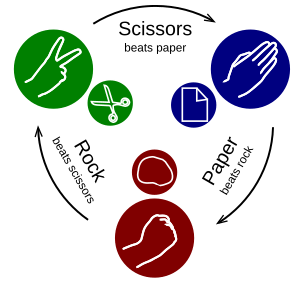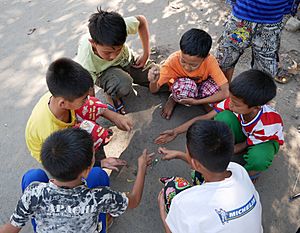Rock-paper-scissors facts for kids
Rock-paper-scissors (also known as paper, scissors, stone or other variants) is a hand game usually played between two people, in which each player simultaneously forms one of three shapes with an outstretched hand. These shapes are "rock" (a closed fist), "paper" (a flat hand), and "scissors" (a fist with the index and middle fingers extended, forming a V). "Scissors" is identical to the two-fingered V sign (aka "victory" or "peace sign") except that it is pointed horizontally instead of being held upright in the air. A simultaneous, zero-sum game, it has only two possible outcomes other than a tie: one of the two players wins, and the other player loses.
A player who decides to play rock will beat another player who has chosen scissors ("rock crushes scissors" or sometimes "blunts scissors"), but will lose to one who has played paper ("paper covers rock"); a play of paper will lose to a play of scissors ("scissors cut[s] paper"). If both players choose the same shape, the game is tied and is usually immediately replayed to break the tie. Originating from China and Japan, other names for the game in the English-speaking world include roshambo and other orderings of the three items, with "rock" sometimes being called "stone".
Rock-paper-scissors is often used as a relatively fair choosing method between two people, similar to coin flipping, drawing straws, or throwing dice in order to settle a dispute or make an unbiased group decision.
Unlike truly random selection methods, however, rock–paper–scissors can be played with a degree of skill by recognizing and exploiting non-random behavior in opponents.
Contents
Game play
The players usually count aloud to 3, or speak the name of the game (e.g. "Rock! Paper! Scissors!" or "Ro Sham Bo!"), each time either raising one hand in a fist and swinging it down on the count or holding it behind. They then "throw" by extending it towards their opponent. Variations include a version where players use only three counts before throwing their gesture (thus throwing on the count of "Scissors!" or "Bo!"), or a version where they shake their hands three times before "throwing".
Strategies
It is impossible to gain an advantage over a truly random opponent. However, by exploiting the weaknesses of non-random opponents, it is possible to gain a significant advantage. Indeed, human players tend to be non-random. As a result, there have been programming competitions for algorithms that play rock–paper–scissors.
In tournament play, some players employ tactics to confuse or trick the other player into making an illegal move, resulting in a loss. One such tactic is to shout the name of one move before throwing another, in order to misdirect and confuse their opponent. During tournaments, players often prepare their sequence of three gestures prior to the tournament's commencement.
The "rock" move, in particular, is notable in that it is typically represented by a closed fist—often identical to the fist made by players during the initial countdown. If a player is attempting to beat their opponent based on quickly reading their hand gesture as the players are making their moves, it is possible to determine if the opponent is about to throw "rock" based on their lack of hand movement, as both "scissors" and "paper" require the player to reposition their hand. This can likewise be used to deceive an anticipating opponent by keeping one's fist closed until the last possible second, leading them to believe that you are about to throw "rock".
Images for kids
-
Cézanne's Large Trees Under the Jas de Bouffan sold for $11,776,000 at Christie's in 2005.
See also
 In Spanish: Piedra, papel o tijera para niños
In Spanish: Piedra, papel o tijera para niños









